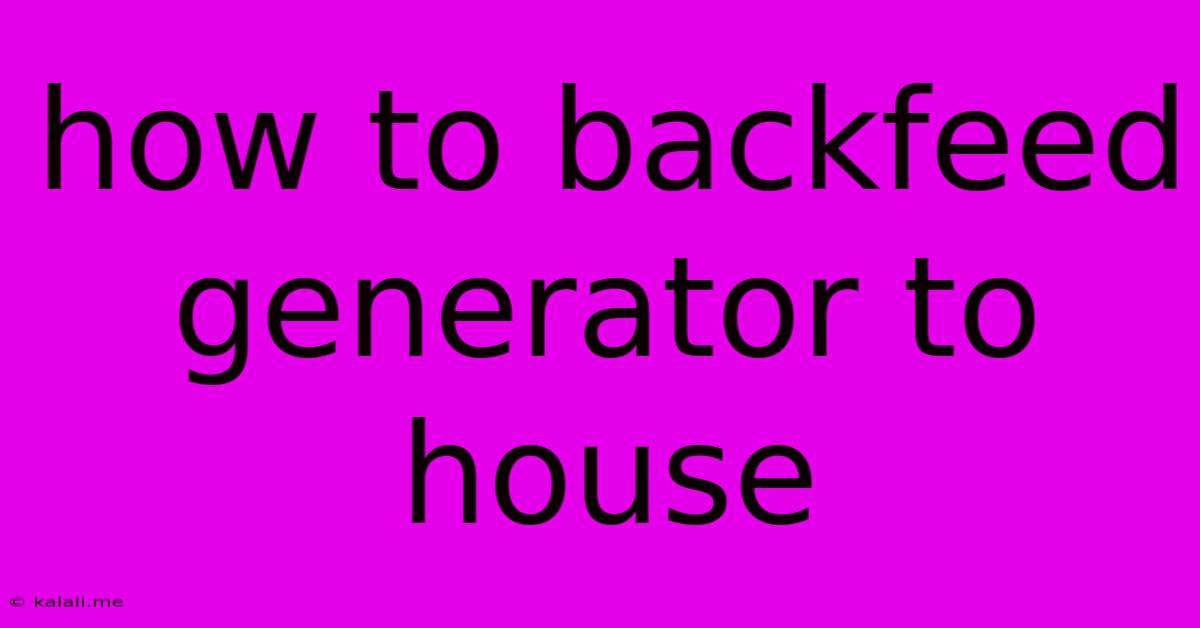How To Backfeed Generator To House
Kalali
May 25, 2025 · 3 min read

Table of Contents
How to Backfeed a Generator to Your House: A Comprehensive Guide
Meta Description: Learn how to safely and effectively backfeed a generator to your home during a power outage. This guide covers essential safety precautions, wiring methods, and crucial considerations for protecting your appliances and yourself.
Power outages can be disruptive and inconvenient, especially during severe weather events. A generator can provide a lifeline, powering essential appliances and keeping your family comfortable. However, improperly connecting a generator to your home's electrical system – a process known as backfeeding – can be extremely dangerous. This guide will walk you through the safe and correct procedures for backfeeding a generator to your house, emphasizing the importance of safety. It's crucial to understand that this is a complex process and should only be undertaken by individuals with a strong understanding of electrical systems or with the help of a qualified electrician.
Understanding the Risks of Backfeeding
Before diving into the process, let's emphasize the inherent dangers. Improper backfeeding can:
- Electrocute you or others: Live wires can cause fatal shocks.
- Damage your appliances: Power surges from improperly connected generators can fry sensitive electronics.
- Start a fire: Overloaded circuits and faulty wiring are significant fire hazards.
- Harm utility workers: Backfeeding can endanger line workers attempting to restore power.
Always prioritize safety. If you're uncomfortable with any aspect of this process, consult a qualified electrician. Their expertise ensures the safety of your home and family.
Methods of Backfeeding a Generator
There are several methods for connecting a generator to your home's electrical system, each with varying levels of complexity and safety considerations.
1. Interlock System: The Safest Option
This method involves installing a generator interlock kit. This kit prevents simultaneous power from the utility company and the generator from flowing into your home, eliminating the risk of backfeeding onto the power grid. It's considered the safest and most recommended approach. Installation requires professional expertise.
2. Manual Transfer Switch: A More Involved Process
A manual transfer switch allows you to manually switch the power source between the utility company and the generator. This method requires disconnecting your home from the main power supply before connecting the generator. This also necessitates a higher level of electrical knowledge and should not be attempted without proper training.
3. Direct Backfeeding (Highly discouraged): Extremely Dangerous
Directly connecting a generator to your home's electrical panel is extremely dangerous and should never be attempted. This method bypasses crucial safety mechanisms and poses a severe risk of electrocution, fire, and damage to your equipment. This approach is illegal in most areas.
Preparing for Generator Backfeeding
Regardless of the chosen method, careful preparation is essential:
- Consult your local electrical codes: Regulations regarding generator installation vary by location.
- Choose the right generator: Select a generator with sufficient power capacity to handle your essential appliances.
- Properly ground the generator: This prevents electrical shocks and ensures safety.
- Use heavy-duty extension cords: Inadequate wiring can overheat and cause fires.
Step-by-Step Guide (with caveats):
This section is for informational purposes only and should NOT be taken as a guide for independent work. The complexity and inherent danger require professional assistance.
A detailed step-by-step guide for any backfeeding method would be extensive and should only be provided by a qualified electrician. Improper installation can have devastating consequences.
Conclusion: Prioritize Safety
Backfeeding a generator to your home requires careful planning, precise execution, and a deep understanding of electrical systems. While providing power during an outage is crucial, safety must always be the top priority. If you're unsure about any aspect of this process, contact a qualified electrician. Their expertise will ensure a safe and reliable power supply during emergencies. This investment in professional help is far less costly than the potential consequences of a poorly executed backfeeding installation.
Latest Posts
Latest Posts
-
How To Remove A Broken Bolt
May 25, 2025
-
Can You Grapple On An Opportunity Attack
May 25, 2025
-
Ffxiv Crafting Failure Get Materials Back
May 25, 2025
-
Meaning Of Wrapped Around Your Finger
May 25, 2025
-
Why Did Kanekis Hair Turn White
May 25, 2025
Related Post
Thank you for visiting our website which covers about How To Backfeed Generator To House . We hope the information provided has been useful to you. Feel free to contact us if you have any questions or need further assistance. See you next time and don't miss to bookmark.